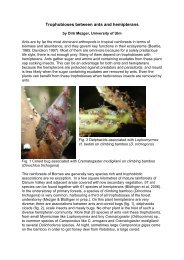Identification guide to the ant genera of Borneo - AntBase.net
Identification guide to the ant genera of Borneo - AntBase.net
Identification guide to the ant genera of Borneo - AntBase.net
You also want an ePaper? Increase the reach of your titles
YUMPU automatically turns print PDFs into web optimized ePapers that Google loves.
Y. HASHIMOTO<br />
Club (CL)<br />
The enlarged apical funicular segments <strong>of</strong> an<br />
<strong>ant</strong>enna. In <strong>ant</strong>s, apical 1-4 segments may be<br />
enlarged <strong>to</strong> form a club.<br />
Frontal carina (FC)<br />
A pair <strong>of</strong> longitudinal ridges on <strong>the</strong> head, located<br />
dorsally behind <strong>the</strong> clypeus and between <strong>the</strong><br />
<strong>ant</strong>ennal sockets. Commonly <strong>the</strong> frontal carinae<br />
<strong>ant</strong>eriorly are expanded in<strong>to</strong> <strong>the</strong> frontal lobes.<br />
See Frontal lobes<br />
Clypeus (CP)<br />
Anterior sclerite <strong>of</strong> <strong>the</strong> dorsal head, bounded<br />
posteriorly by <strong>the</strong> fron<strong>to</strong>-clypeal suture (= posterior<br />
clypeal margin or border, FS). The <strong>ant</strong>erior clypeal<br />
margin usually forms <strong>the</strong> <strong>ant</strong>erior margin <strong>of</strong> <strong>the</strong><br />
head in full-face view. The body <strong>of</strong> <strong>the</strong> clypeus<br />
consists <strong>of</strong> median portion and a pair <strong>of</strong> lateral<br />
portions (MC, LC). The median portion <strong>of</strong> <strong>the</strong><br />
clypeus may be equipped with one or more<br />
longitudinal carinae, or may be variously specialized<br />
in shape.<br />
Frontal lobe (FB)<br />
The frontal lobes commonly are extensions, which<br />
partially or entirely cover and conceal <strong>the</strong> <strong>ant</strong>ennal<br />
sockets.<br />
In some taxa <strong>the</strong> clypeus is very reduced and<br />
extremely narrow from front <strong>to</strong> back.<br />
Leg segments<br />
Each leg consists <strong>of</strong> a basal coxa (BC) that articulates<br />
with <strong>the</strong> alitrunk, followed in order by a troch<strong>ant</strong>er<br />
(TR), femur (FE), a tibia (TB), and a tarsus (TA), <strong>the</strong><br />
last consisting <strong>of</strong> five small segments and<br />
terminating apically in a pair <strong>of</strong> claws (CA).<br />
Tibial spur (TBS) A socketed spur located at <strong>the</strong> apex<br />
<strong>of</strong> each tibia. The forelegs have a single pectinate<br />
tibial spur, modified in<strong>to</strong> an <strong>ant</strong>ennal cleaner<br />
(strigil). The middle and hind legs may each have<br />
two, one, or no spurs present.<br />
140 Part 3 - COLLECTING, HANDLING, IDENTIFICATION AND STORAGE FOR SELECTED GROUPS




